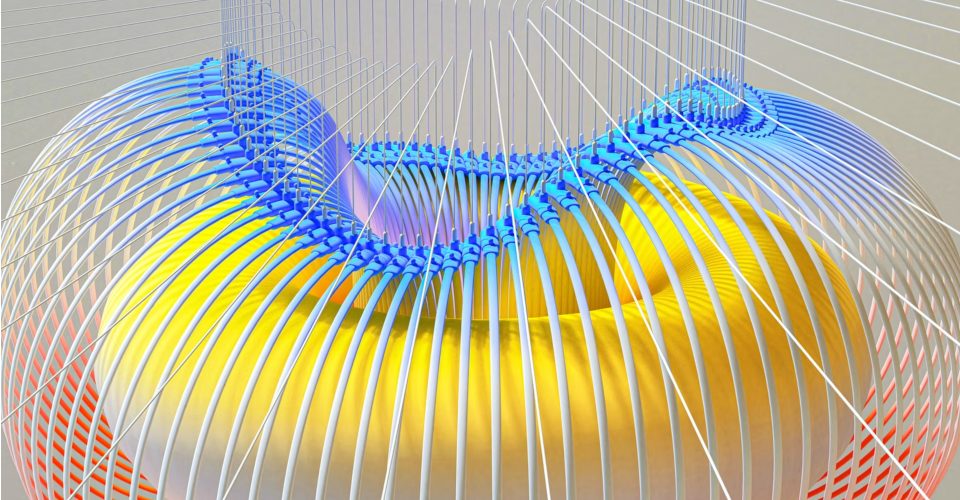3D Printing with Rainbow Filament – Tips and Best Brands
Why 3D print with a single color when you can print with several simultaneously? Rainbow filaments make it possible to make multicolor prints without having to print with multiple spools. They are tremendously fun, but also unpredictable.
There actually are ways to control how a rainbow print will look like by just changing your slicer settings. There is also a great variety of rainbow filaments out there, with colors that may not necessarily follow the standard rainbow scheme. Check out this guide on making successful rainbow prints.
What is rainbow filament?
Rainbow filament can refer to any filament that has a color gradient instead of just a single color scheme. This color gradient may not necessarily have all the colors of the rainbow. The usual variations keep the colors to those of similar hues or hues that are complementary.
In the past, rainbow filament that was made of anything other than PLA was extremely rare. Nowadays, it has become a lot easier to find different filament materials with rainbow colors such as PETG or TPU. Still, PLA is still the most common material for rainbow filament since it works out quite well for display pieces. This also makes rainbow filament accessible to beginners.
Most rainbow filament advertise a color change every 3 to 5 meters. There are gradual transition zones between different hues. The end result should be a 3D print with a smooth color gradient from top to bottom. The rate of color change can vary based on the filament, but it can also be influenced by changing your slicer settings.
Top 5 rainbow filament recommendations
There are a lot of generic rainbow filaments out there that look and perform very similarly to each other. Instead of repeating these similar entries, this list was crafted to offer a variety of different rainbow filaments.
1. TTYT3D Rainbow Silk PLA Filament
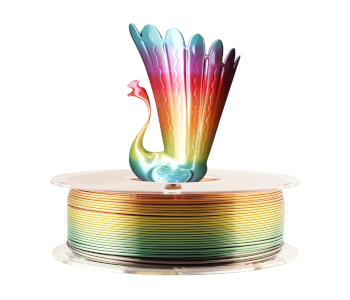
We will start this list with the most basic rainbow filament made with a Silk PLA base material. This gives finished 3D prints a very shiny finish that helps in making layer lines less visible.
The filament of TTYT3D is a true rainbow filament that goes through all the colors in the visible spectrum. With a color change every 3 to 5 meters, this filament is advertised as having a fast color gradient.
The glossy finish and color gradient of this filament makes it excellent for 3D printing in vase mode. This takes full advantage of the fast gradient without making the transitions too drastic. This filament prints almost as easily as standard PLA, although the manufacturer recommends printing it on a heated bed.
It’s worth noting that there are probably more than a dozen filaments out there that look exactly like this rainbow filament.
2. AMOLEN Glow in the Dark Rainbow PLA Filament
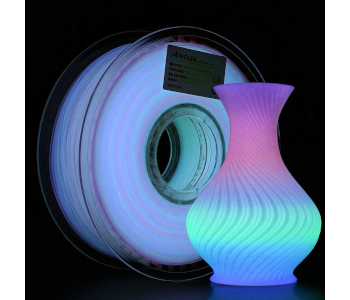
This PLA filament from AMOLEN kicks it up a notch by integrating glow-in-the-dark particles with a rainbow color scheme. The result is an absolutely gorgeous filament that can be great for 3D printing toys, containers, and other display items for kids.
Just like any glow-in-the-dark filament, this filament from AMOLEN appears to only have a faint green hue when seen under light. Once it has absorbed UV light and is placed in a dark room, it glows in colors ranging from magenta to blue and purple. The effect is mesmerizing, and it’s a nice touch to now know exactly how the finished print will look until you see it in the dark.
As with other PLA filaments that have embedded particles, it is best to print this with a wide-diameter nozzle. It is also a brittle filament, so best to handle it with care. AMOLEN has an entire line of glow-in-the-dark filaments but this multicolor variation takes the cake.
3. CC3D Purple to Pink Color Change PLA Filament
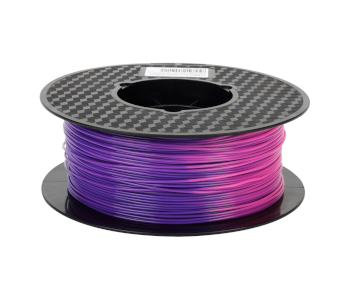
As mentioned, not all rainbow filaments feature the entire range of colors of the rainbow. If you want something more subtle, there are multicolor filaments that restrict the hues to a narrower spectrum. A good example is this multicolor filament from CC3D that features colors from pink to purple.
Another interesting characteristic of this filament is that the color of the material changes with the temperature. At normal room temperature, the filament has a purple color. When exposed to higher temperatures, it very slowly transforms to bright pink. This is quite fun to play with and will slowly be impressive for kids. The filament is very sensitive to temperature changes – just breathing on it will already change the color.
4. 3DF Rainbow PETG Filament
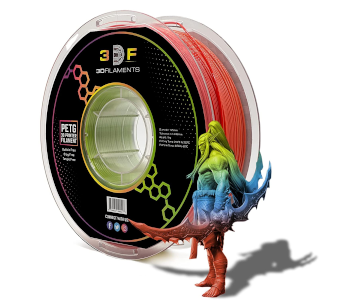
PLA is over-represented when it comes to rainbow filament, so coming across this PETG filament with a rainbow color scheme helps break the monotony. The color of this filament transitions across red, orange, green, and blue. While this isn’t the most complementary palette, there are lots of creative ways that this color range can be used creatively.
Of course, the major advantage of working with PETG is that it’s mechanically and thermally more resilient than PLA. It does print at a higher temperature and you will definitely need to have a heated print bed. 3DF also sells a Rainbow ABS Filament.
5. Reprapper Dual Color Matte PLA Filament
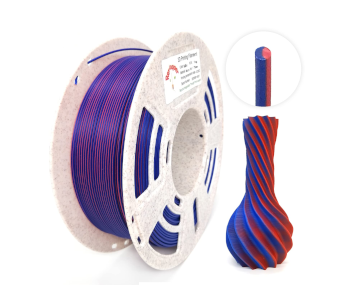
This filament from Reprapper has a bit of a unique take on the rainbow filament concept. Instead of the different colors taking up separate segments of the filament, this filament is colored red on one side and blue on the other. This translates very well to 3D prints as they end up with different colors across the two halves.
The matte finish of the filament gives the finished 3D prints from this filament a unique character. Of course, you can also smooth and polish the surface of the 3D print to make it glossy. Either way, the colors are very vibrant and can produce really good prints.
Tips on printing with rainbow filament
Experimenting with rainbow filament is very fun, especially if you swap between different colors and brands. There really is no wrong way to go about 3D printing with rainbow filament, and any technique is valid as long as you like the results you are getting. However, there are changes to slicer settings you can make to get specific results.
Print large models
The best way to show off a rainbow gradient filament is to print a fairly large model. Since the different colors in a filament transition occur over a few meters, a color change may not be apparent if you’re just printing a small figure. It would be best to maximize the build volume of your 3D printer, just for kicks.
Print at low infill
When printing with a rainbow filament, you want your finished product to take on the filament’s actual gradient. However, some of the filament will inevitably end up in the inner shells of the print as well as the infill. This is kind of a waste since this is material that is not visible.
If you have to print with infill, then it’s best to keep it close to 50%. This helps retain the rainbow gradient and prevents the transition between different colors to be too sudden. This gentle transition is precisely what you are looking for.
Print in vase mode
The ultimate printing technique for avoiding too much infill, of course, is to print in vase mode. This prints with a minimal number of shells and no infill. This makes the transition between the different colors exceptionally smooth and really shows off the gradient of the filament.
Again, there are no strict rules to follow here. Printing with rainbow filaments is typically done for fun. There will still be a certain level of unpredictability whenever you print with rainbow filaments, even if you stick to these rules. That’s kind of the thing when you use a rainbow filament – you just have to go with the flow.
Final thoughts
Printing with rainbow filament is just about the most fun you can get from 3D printing. They are unpredictable, but they typically will produce beautiful products. One of the best things about printing with rainbow filaments is that the product may look different every single time.
You don’t necessarily need to stick to a filament that has a rainbow color gradient. As our recommendations show, there actually is a healthy selection of different types of multicolor or “rainbow” filaments. There is a lot of creative room to explore here and rainbow filament is the perfect material to experiment with.

